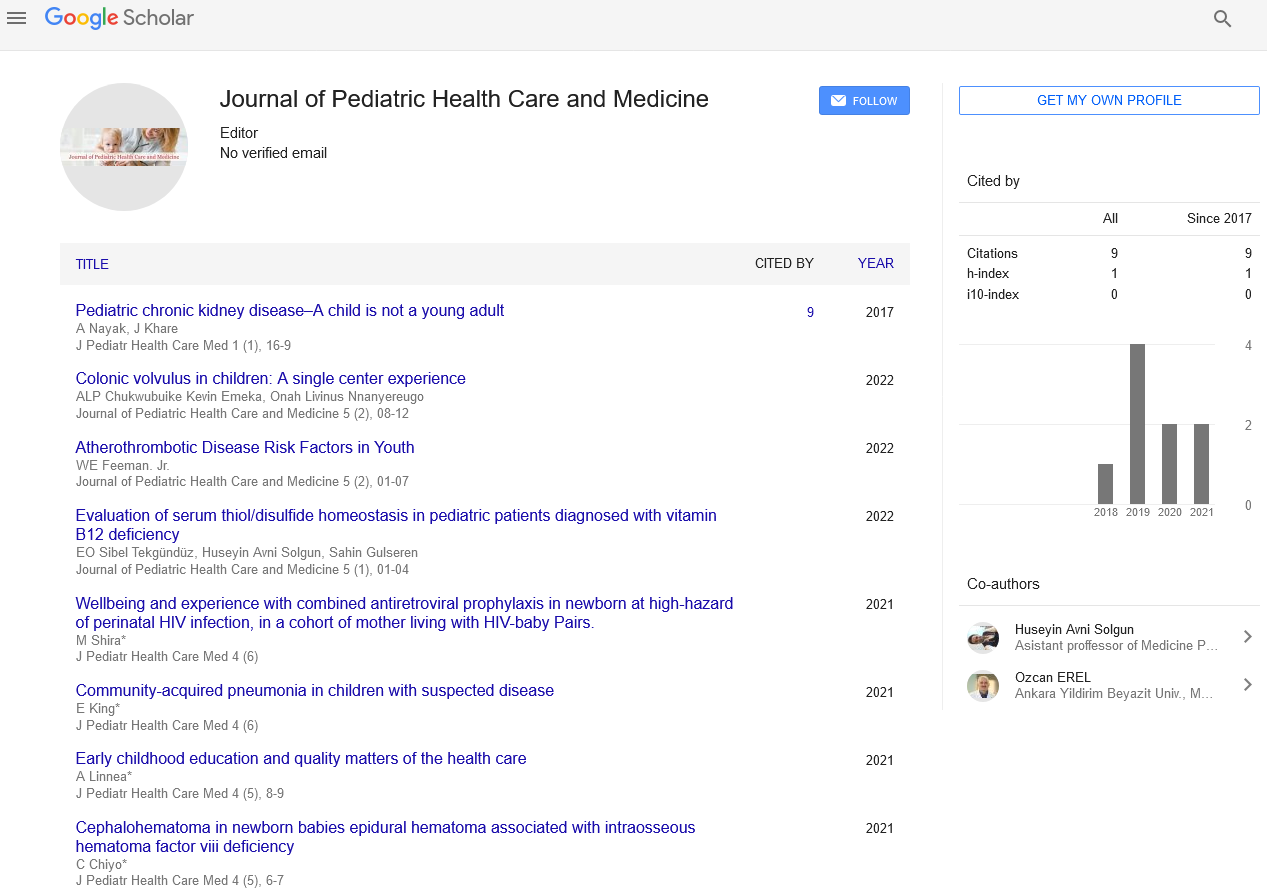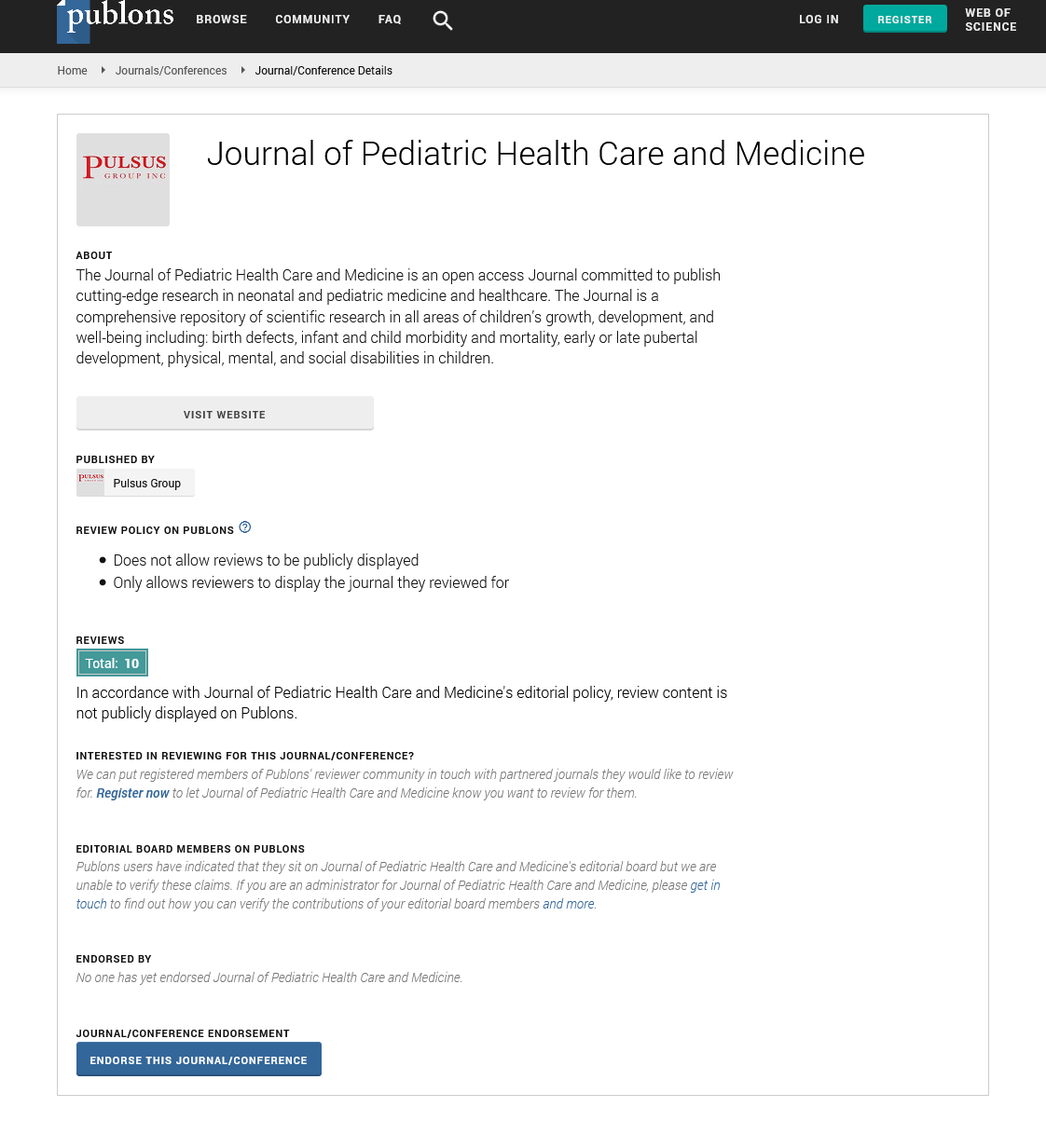Cardiac murmurs in the newborn
Received: 09-Jan-2022, Manuscript No. PULJPHCM-22-4111; Editor assigned: 13-Jan-2022, Pre QC No. PULJPHCM-22-4111; Accepted Date: Jan 13, 2022; Reviewed: 17-Jan-2022 QC No. PULJPHCM-22-4111; Revised: 22-Jan-2022, Manuscript No. PULJPHCM-22-4111; Published: 28-Jan-2022, DOI: 10.37532/ puljphcm.2022.5(1).9-10
Citation: Bravo L. Cardiac murmurs in the newborn. J Pedia Health Care Med. 2022;5(1):09-10.
This open-access article is distributed under the terms of the Creative Commons Attribution Non-Commercial License (CC BY-NC) (http://creativecommons.org/licenses/by-nc/4.0/), which permits reuse, distribution and reproduction of the article, provided that the original work is properly cited and the reuse is restricted to noncommercial purposes. For commercial reuse, contact reprints@pulsus.com
Abstract
Congenital Heart Disease (CHD) accounts for a significant share of baby and young child mortality. Newborns (from birth to one month of age) are more likely than older babies and toddlers to have a major lesion that requires immediate treatment. On physical examination, detecting a murmur in a baby can give a clue to the presence of CHD, but its value is limited by provider competence and neonatal variables including high heart rate and respiratory symptoms. In addition, not all murmurs are harmful. When assessing if a murmur needs additional study, health care providers such as primary care doctors, pediatricians, and nurse practitioners frequently confront challenges.
Keywords
Congenital heart disease murmur; Pulse oximetry screening; Infant heart murmurs; Heart murmurs in new born babies
Introduction
Congenital Heart Disease (CHD) accounts for a significant share of baby and young child mortality. Newborns (from birth to one month of age) are more likely than older babies and toddlers to have a major lesion that requires immediate treatment. On physical examination, detecting a murmur in a baby can give a clue to the presence of CHD, but its value is limited by provider competence and neonatal variables including high heart rate and respiratory symptoms. In addition, not all murmurs are harmful. When assessing if a murmur needs additional study, health care providers such as primary care doctors, pediatricians, and nurse practitioners frequently confront challenges. The goal of this study is to characterize the fundamental distinctions between benign and abnormal cardiac murmurs in newborns. We also go through current screening techniques for Critical Congenital Heart Defects (CCHD) that can help primary care doctors decide whether to send patients for additional testing.
Evaluating a newborn with heart murmur
In the general population, the prevalence of Congenital Heart Disease (CHD) is less than 1% [1-6]. In newborns and older children, heart murmurs are a regular occurrence. In the first few days of life, less than 1% of newborn newborns have an audible murmur [4, 5]. A murmur, in fact, may be the only sign of a severe and possibly fatal CHD classified as a Critical Congenital Heart Defect (CCHD) [7]. On echocardiography, more than half of neonates with a cardiac murmur had a structural heart defect [7-9]. However, not every murmur is harmful; the rest are called innocent or physiological murmurs since they arise from normal flow patterns in the absence of anatomic cardiac defects. A transitional circulation, which is frequently connected to the Patency of the Ductus Arteriosus (PDA) or its closure, can also cause cardiac murmurs in newborns. Another part of the transitional circulation that is not usually clinically detectable is the Patent Foramen Ovale (PFO) [10].
Health care workers face a difficult task in determining the cause of a murmur in a baby. As a result, they continue to be the most prevalent reason for consulting a pediatric cardiologist in neonatal critical care units and nurseries [11, 12]. A comprehensive examination, which includes a detailed history and physical examination, is the first step in identifying neonates with pathological murmurs who are at a higher risk of CHD.
Pulse oximetry screening
Although some pediatricians and neonatologists may rule out heart disease based on a clinical exam alone, the clinical exam is less accurate in younger children, and up to half of kids with CHD may be missed, requiring an echocardiography to be ruled out completely [13,14]. Due to disparities in clinical experience, the ability to reliably diagnose pathologic murmurs in the infant by clinical examination alone varies even across subspecialists, with sensitivities ranging from 80.5% to 94.9% and specificities ranging from 25% to 92% [15]. Furthermore, CHD can arise without a heart murmur or other clinical symptoms [16]. According to one study, the detection rate for abnormal heart murmurs in newborns by inspection alone was roughly 50% when validated by echocardiography. As a result of these difficulties, several techniques have emerged to assist clinicians in screening newborns for CHD.
Pulse Oximetry Screening (POS) has been found to be a reliable, costeffective, and noninvasive screening approach for CCHD identification with high specificity (99.9%) and moderate sensitivity (76.5%) with sensitivity improving (82%-92%) when paired with physical examination [17-19]. Duct-dependent cardiac abnormalities (hypo plastic left heart syndrome, pulmonary atresia, transposition of the great arteries, and tricuspid atresia) and cyanotic heart lesions are among the CCHD lesions [18].
It is crucial to discover CCHD early in order to provide prompt intervention and surgical care. Routine POS for all infants is recommended by the Canadian Pediatric Society (CPS) and the American Academy of Pediatrics (AAP). Saturations of less than 90% on the right hand (preductal saturation) or any foot (post-ductal saturation), less than 95% in both extremities after three measurements, or a difference of more than 3% between pre-ductal and post-ductal saturations after three measurements indicate a positive screen [19]. Infants who have a positive screen should be evaluated further, which may include an examination by a pediatric cardiologist and an echocardiography. False positive screenings can occur as a result of various disorders that cause hypoxia, such as hemoglobinopathies or infant pulmonary hypertension. Routine POS should be done between the ages of 24 and 36 hours, since screening before that time increases the incidence of false positives.
Determining when to refer in the setting of CH
To identify whether to send to pediatric cardiology, a complete history, physical examination, including auscultation for fetal murmur, and pulse oximetry screening must be carefully coupled. The value of POS is in distinguishing neonates at risk for CCHD who need to be sent to a pediatric cardiology specialist very away. Prior to a newborn’s release from the hospital, we urge that POS be adopted globally. Newborns with a heart murmur that pass the POS but have red flags on their history or physical examination should be referred for additional evaluation. Finally, a newborn with a murmur and negative POS should be continuously monitored by their main physician for any signs of cyanosis, cardiac failure, failure to thrive, or feeding intolerance. Reassessment may reveal red flags, or the murmur features may become problematic, in which case the infant should be evaluated further. It should be noted that our final suggestion may differ depending on clinical expertise, geographic area, and follow-up availability.
When it comes to juvenile cardiology, we urge that the main physician do no more diagnostic tests. Electrocardiograms and chest x-rays are rarely helpful in diagnosing a cardiac murmur and so are not cost-effective. The use of electrocardiography did not increase sensitivity in the identification of CHD in a trial conducted by Mackie et al. [15].
Phonocardiography may be explored in geographically isolated places where pediatric cardiologists are unavailable for immediate referral. Phonocardiography uses digital heart sound recordings that may be analyzed remotely by a pediatric cardiologist to discern between benign murmurs and pathologic murmurs. Newborns with murmurs that are suspected to be pathogenic should be taken to a clinic where an echocardiography and evaluation by a pediatric cardiologist can be performed.
Conclusion
Healthcare practitioners continue to be challenged with neonatal heart murmurs. There may not be enough evidence to clearly rule out a structural cardiac lesion based only on their audio features. However, a thorough medical history and physical examination are still required to detect the important signs and symptoms that may indicate the presence of serious congenital heart disease (CCHD). Although POS has been found to enhance the diagnosis of CCHD, any infant with a heart murmur should be evaluated by a health care practitioner after discharge, as attentive follow-up of all newborns is essential, since a newborn with CCHD may escape early screening. An urgent referral to a pediatric cardiologist for rapid screening is required for neonates with clinical signs indicative of a cardiac problem (e.g., failure to thrive/poor feeding, cyanosis, reduced pulses, respiratory distress) or a pathologic heart examination.
REFERENCES
- Thangaratinam S, Brown K, Zamora J, et al. Pulse oximetry screening for critical congenital heart defects in asymptomatic newborn babies: A systematic review and meta-analysis. The Lancet. 2012; 379: 2459-2464.
Google Scholar Cross Ref - Wong KK, Fournier A, Fruitman DS, et al. Canadian Cardiovascular Society/Canadian Pediatric Cardiology Association position statement on pulse oximetry screening in newborns to enhance detection of critical congenital heart disease. Can J Cardiol. 2017; 33: 199-208.
Google Scholar Cross Ref - Narvey M, Wong KK, Fournier A. Pulse oximetry screening in newborns to enhance detection of critical congenital heart disease. Paediatr Child Health. 2017; 22: 494-498.
Google Scholar Cross Ref - Frank JE, Jacobe KM. Evaluation and management of heart murmurs in children. Am Fam Physician. 2011; 84: 793-800.
Google Scholar Cross Ref - Khalilian MR, Malekian A, Aramesh MR, et al. Innocent versus pathologic murmurs: A challenge of neonatal examination. J Clin Neonatol. 2016; 5: 174-178.
Google Scholar Cross Ref - Mahle W, Newburger J, Matherne G, et al. Role of pulse oximetry in examining newborns for congenital heart disease: A scientific statement from the AHA and AAP. Pediatrics. 2009; 124: 823-836.
Google Scholar Cross Ref - Rein AJ, Omokhodion SI, Nir A. Significance of a cardiac murmur as the sole clinical sign in the newborn. Clin Pediatr (Phila). 2000; 39: 511-520.
Google Scholar Cross Ref - Bansal M, Jain H. Cardiac murmur in neonates. Indian Pediatr. 2005; 42: 397-398.
Google Scholar Cross Ref - Ainsworth S, Wyllie JP, Wren C. Prevalence and clinical significance of cardiac murmurs in neonates. Arch Dis Child Fetal Neonatal (Edn). 1999; 80: 43-45.
Google Scholar Cross Ref - Arlettaz R, Archer N, Wilkinson AR. Natural history of innocent heart murmurs in newborn babies: controlled echocardiographic study. Arch Dis Child Fetal Neonatal Ed. 1998; 78(3): 166-170.
Google Scholar Cross Ref - Geggel RL. Conditions leading to pediatric cardiology consultation in a tertiary academic hospital. Pediatrics. 2004; 114(4): e409-e417.
Google Scholar Cross Ref - Al-Ammouri I, Ayoub F, Dababneh R. Is pre-discharge echocardiography indicated for asymptomatic neonates with a heart murmur? A retrospective analysis. Cardiol Young. 2016; 26(6): 1056-1059.
Google Scholar Cross Ref - Etoom Y, Ratnapalan S. Evaluation of children with heart murmurs. Clin Pediatr (Phila). 2014; 53(2): 111-117.
Google Scholar Cross Ref - Kardasevic M, Kardasevic A. The importance of heart murmur in the neonatal period and justification of echocardiographic review. Med Arch. 2014; 68(4): 282-284.
Google Scholar Cross Ref - Mackie AS, Jutras LC, Dancea AB, et al. Can cardiologists distinguish innocent from pathological murmurs in neonates? J Pediatr. 2009; 154(1): 50-54.
Google Scholar Cross Ref - Azhar AS, Habib HS. Accuracy of the initial evaluation of heart murmurs in neonates: Do we need an echocardiogram? Pediatr Cardiol. 2006; 27(2): 234-237.
Google Scholar Cross Ref - Zhao QM, Ma XJ, Ge XL, et al. Pulse oximetry with clinical assessment to screen for congenital heart disease in neonates in China: A prospective study. Lancet. 2014; 384(14): 747-754.
Google Scholar Cross Ref - Mahle WT, Martin GR, Beekman RH, et al. Endorsement of health and human services recommendation for pulse oximetry screening for critical congenital heart disease. Pediatrics. 2012; 129(1): 190-192.
Google Scholar Cross Ref - Narayen IC, Blom NA, van Geloven N, et al. Accuracy of pulse oximetry screening for critical congenital heart defects after home birth and early postnatal discharge. J Pediatr. 2018; 197: 29-35.
Google Scholar Cross Ref






